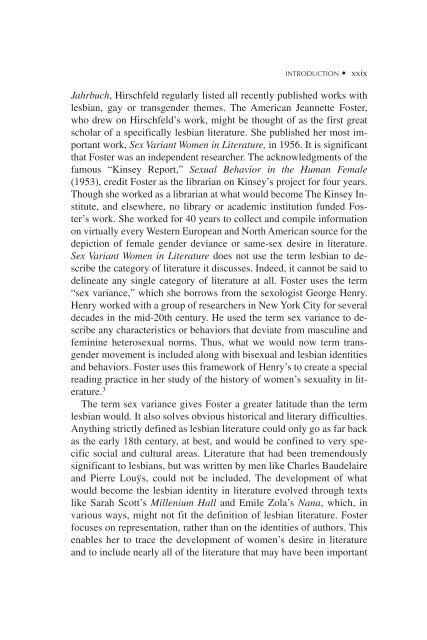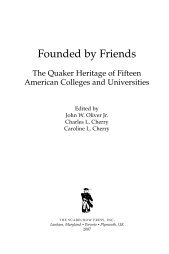Historical Dictionary of Lesbian Literature - Scarecrow Press
Historical Dictionary of Lesbian Literature - Scarecrow Press
Historical Dictionary of Lesbian Literature - Scarecrow Press
You also want an ePaper? Increase the reach of your titles
YUMPU automatically turns print PDFs into web optimized ePapers that Google loves.
INTRODUCTION • xxix<br />
Jahrbuch, Hirschfeld regularly listed all recently published works with<br />
lesbian, gay or transgender themes. The American Jeannette Foster,<br />
who drew on Hirschfeld’s work, might be thought <strong>of</strong> as the first great<br />
scholar <strong>of</strong> a specifically lesbian literature. She published her most important<br />
work, Sex Variant Women in <strong>Literature</strong>, in 1956. It is significant<br />
that Foster was an independent researcher. The acknowledgments <strong>of</strong> the<br />
famous “Kinsey Report,” Sexual Behavior in the Human Female<br />
(1953), credit Foster as the librarian on Kinsey’s project for four years.<br />
Though she worked as a librarian at what would become The Kinsey Institute,<br />
and elsewhere, no library or academic institution funded Foster’s<br />
work. She worked for 40 years to collect and compile information<br />
on virtually every Western European and North American source for the<br />
depiction <strong>of</strong> female gender deviance or same-sex desire in literature.<br />
Sex Variant Women in <strong>Literature</strong> does not use the term lesbian to describe<br />
the category <strong>of</strong> literature it discusses. Indeed, it cannot be said to<br />
delineate any single category <strong>of</strong> literature at all. Foster uses the term<br />
“sex variance,” which she borrows from the sexologist George Henry.<br />
Henry worked with a group <strong>of</strong> researchers in New York City for several<br />
decades in the mid-20th century. He used the term sex variance to describe<br />
any characteristics or behaviors that deviate from masculine and<br />
feminine heterosexual norms. Thus, what we would now term transgender<br />
movement is included along with bisexual and lesbian identities<br />
and behaviors. Foster uses this framework <strong>of</strong> Henry’s to create a special<br />
reading practice in her study <strong>of</strong> the history <strong>of</strong> women’s sexuality in literature.<br />
3<br />
The term sex variance gives Foster a greater latitude than the term<br />
lesbian would. It also solves obvious historical and literary difficulties.<br />
Anything strictly defined as lesbian literature could only go as far back<br />
as the early 18th century, at best, and would be confined to very specific<br />
social and cultural areas. <strong>Literature</strong> that had been tremendously<br />
significant to lesbians, but was written by men like Charles Baudelaire<br />
and Pierre Louÿs, could not be included. The development <strong>of</strong> what<br />
would become the lesbian identity in literature evolved through texts<br />
like Sarah Scott’s Millenium Hall and Emile Zola’s Nana, which, in<br />
various ways, might not fit the definition <strong>of</strong> lesbian literature. Foster<br />
focuses on representation, rather than on the identities <strong>of</strong> authors. This<br />
enables her to trace the development <strong>of</strong> women’s desire in literature<br />
and to include nearly all <strong>of</strong> the literature that may have been important
















